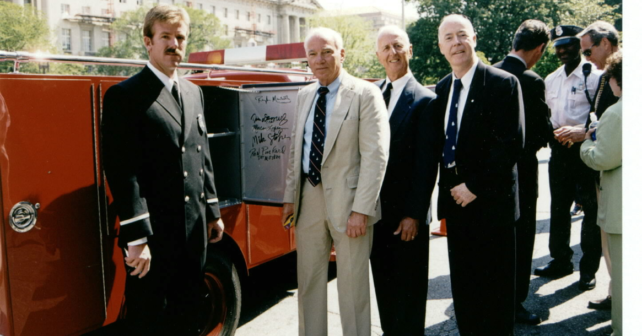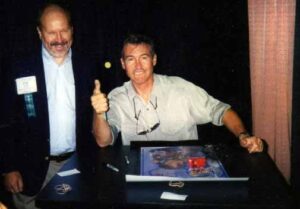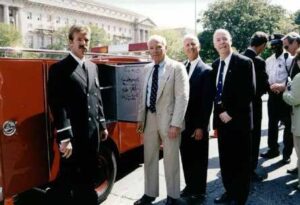

Explore This Issue
ACEP Now: Vol 41 – No 06 – June 2022Rick Murray (left) meeting Randolph Mantooth (right) who played Johnny Gage in Emergency! in 2000. Gage was showing Murray how he flipped the caps off the end of the sodium bicarbonate tunes.
Within a year of beginning the residency, Dr. Stewart had become medical director of Los Angeles counties’ paramedic training institute, which put him at the center of their rapidly developing program. By day he was busy trying to finish his residency and do research. The only time he was available to be in the streets with the film crew was at night.
“I would spend all of my spare time trying to understand what these paramedics needed to know because there were no textbooks at the time. I had to write one myself and it was really very hard to keep up the pace,” he said.
Worst of all, in his estimation, was that his consulting role also included answering medical fan mail, a task Dr. Stewart described as, “terrible.”
“I quit doing it when I got one note written in pencil from someone in the Midwest saying, ‘I saved my granny from death with that CPR stuff I saw on Emergency! But there was one problem, she kept getting up,’” he says, laughing.

Emergency! medical pioneers including Dr. Stewart at the Smithsonian National Museum of American History.
The role did have its upsides, Dr. Stewart would soon learn. One was working with Producer Bob Cinader, a man Dr. Stewart describes as an occasionally brusque but brilliant Hollywood producer who also happened to be crazy about fire engines and loved listening to bagpipe music. “I happen to be a piper,” Dr. Stewart says. “So we got along very nicely and ultimately became quite close. We all thought a lot of him.”
Cinader, who died in 1982, would take Dr. Stewart to bagpipe concerts and encourage the show’s stars, Randy Mantooth, who played Johnny Gage, and Kevin Tighe, who played Roy Desoto to join them. They all had fun and became friends; Dr. Stewart still keeps in touch with the actors and several others from the series.
Dr. Stewart used to downplay the show, thinking it wasn’t really doing anything of value. They couldn’t show blood. They couldn’t show a patient dying. And at that time, in real life, it wasn’t legal for paramedics to run IVs or defibrillate, so in the very early days of the program when a call came in from the dispatcher, the paramedics got on the truck and would have to pick up the coronary care nurse at the hospital to respond to someone having a heart attack. “With that system in the unwitnessed cardiac arrest and without citizen CPR, the survival rate would be zero,” Dr. Stewart says. “All of that changed with legislation.”
Pages: 1 2 3 | Single Page


One Response to ““Emergency!” A TV Series That Transformed Pre-Hospital Care, Turns 50”
May 21, 2022
Walter Schrading, MD, FACEP, FAWMRon Stewart has mentored a generation of emergency care providers, including me! He has improved EMS care immeasurably. Thank you Ron, for your years of service and many accomplishments.